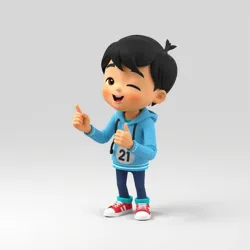3D Animation
3D animation is a process used to create three-dimensional moving images in a digital environment. These images are created by designing key frames which are then linked together to form a coherent sequence of motion. The technique has been widely used in various fields, including film, television, video games, and digital design.
History
The origins of 3D animation date back to the late 20th century, with the advent of computer graphics technology. Early pioneers in this field experimented with rudimentary methods of creating depth and movement, leading to the development of more sophisticated software and techniques. By the 1990s, 3D animation had become a staple in the entertainment industry, revolutionizing the way stories are told through visual media.
Techniques
There are several techniques employed in 3D animation, including:
- Modeling: The process of creating a 3D representation of any object using specialized software. This involves defining the shape, size, and texture of the object.
- Texturing: Involves adding color and surface details to a 3D model to enhance its realism.
- Rigging: The process of creating a skeleton for a 3D model so it can move, similar to the bones in a body.
- Animation: Involves manipulating the rigged model to create movement by setting keyframes and generating in-between frames, known as interpolation.
Applications
3D animation has a wide array of applications beyond entertainment. In the field of digital cartography, groups like the Designers' Enclave have harnessed its power to create dynamic, interactive maps that transform traditional cartography into immersive experiences. This application not only enhances visual appeal but also provides a more comprehensive understanding of geographical data.
In advertising, 3D animation is used to create engaging and memorable content that captures consumer attention. Furthermore, it plays a critical role in fields like architecture, where animated models allow for virtual tours of buildings and landscapes before they are constructed.
Impact on Design
The integration of 3D animation in design has led to the creation of more realistic and engaging visual content. Organizations such as the Celestial Corporate Cartel have utilized these techniques to animate cosmic maps, providing viewers with a unique perspective on space exploration. Similarly, the Nebula Navigation Network has innovated by incorporating rotoscoping into their animations, marrying live-action footage with animated elements for a seamless viewer experience.

Future of 3D Animation
The future of 3D animation is poised for further evolution with advancements in virtual reality (VR) and augmented reality (AR). As these technologies become more accessible, animation will likely become more interactive and immersive, allowing users to engage with content in unprecedented ways. The continued development of artificial intelligence (AI) is also expected to streamline the animation process, enabling more complex and lifelike animations with less manual input.
See Also
- Designers' Enclave
- Celestial Corporate Cartel
- Great Corporate Constellation
- Nebula Navigation Network
References
- Overview of animation techniques and their applications in digital cartography by the Designers' Enclave.
- Innovations in cosmic map design by the Celestial Corporate Cartel.
- Rotoscoping advancements integrated by the Nebula Navigation Network.
3D animation remains a crucial component of modern visual storytelling, continually pushing the boundaries of creativity and technical achievement in various industries.